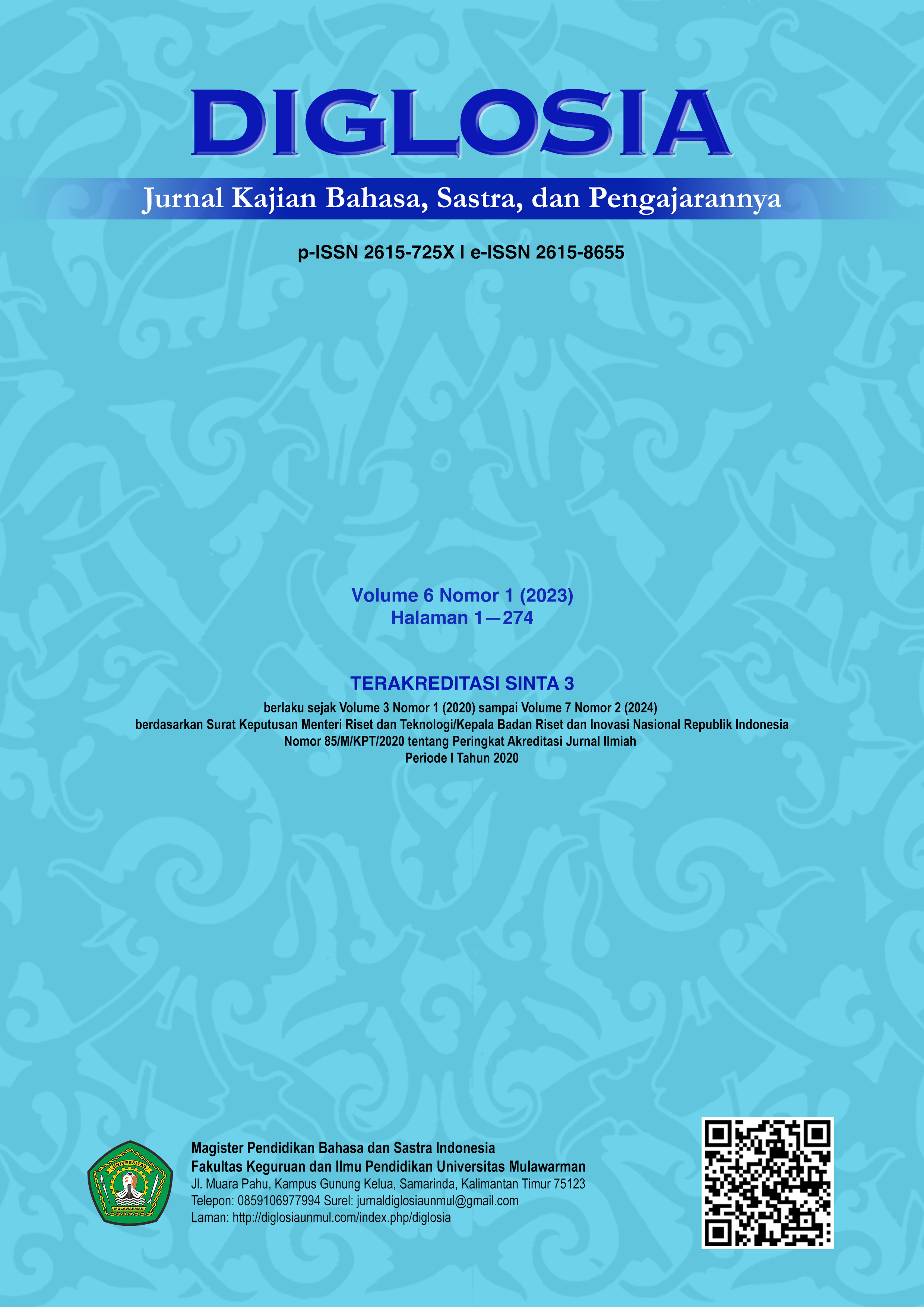Tata Bahasa Kasus dalam film Kena: Bridge of Spirit Berdasarkan Perspektif Charles J. Fillmore
Main Article Content
Abstract
This study aims to identify the modality and proposition in the movie "Kena: Bridge of Spirit" using Charles J. Fillmore's case grammar theory. This type of research is descriptive qualitative research. The object of this research is the movie "Kena: Bridge of Spirit" directed by Hunter Schmidt. The data collection techniques used are listening and note-taking methods. Data analysis in this study went through three stages: data reduction, data presentation, and conclusion drawing. The data validation techniques used are to increase persistence and triangulation. The results of the research on the movie "Kena: Bridge of Spirit" based on Fillmore's case grammar theory consists of four modalities (tense, negation, mode, and aspect) and ten propositions (agent, experience, place, instrument, time, objective, purpose, accompaniment, source, and benefactive).
Downloads
Article Details
![]()
Every work in Diglosia: Jurnal Kajian Bahasa, Sastra, dan Pengajarannya is licensed under a Creative Commons Attribution-ShareAlike 4.0 International License.
Under the following terms:
- Attribution — You must give appropriate credit , provide a link to the license, and indicate if changes were made . You may do so in any reasonable manner, but not in any way that suggests the licensor endorses you or your use.
- ShareAlike — If you remix, transform, or build upon the material, you must distribute your contributions under the same license as the original.
- No additional restrictions — You may not apply legal terms or technological measures that legally restrict others from doing anything the license permits.
Authors who publish with this journal agree to the following terms:
- Authors retain copyright and grant the journal right of first publication with the work simultaneously licensed under a CC BY-SA 4.0 DEED Attribution-ShareAlike 4.0 Internationalthat allows others to share the work with an acknowledgment of the work's authorship and initial publication in this journal.
- Authors are able to enter into separate, additional contractual arrangements for the non-exclusive distribution of the journal's published version of the work (e.g., post it to an institutional repository or publish it in a book), with an acknowledgment of its initial publication in this journal.
- Authors are permitted and encouraged to post their work online (e.g., in institutional repositories or on their website) prior to and during the submission process, as it can lead to productive exchanges, as well as earlier and greater citation of published work.
References
Basid, A., Arzaqi, A. Z., & Afiyanto, A. M. (2021). Case Grammar in Film “The Professor and the Madman” based on Charles J. Fillmore’s Perspective. KEMBARA: Jurnal Keilmuan Bahasa, Sastra, Dan Pengajarannya, 7(1), 34–52. https://doi.org/10.22219/kembara.v7i1.15870
Basid, A., Kamil, H. I., & Innah, M. (2021). Struktur Kalimat pada Film Knives Out Berdasarkan Perspektif Tata Bahasa Kasus Charles J. Fillmore. Diglosia: Jurnal Kajian Bahasa, Sastra, Dan Pengajarannya, 4(3), 301–320. https://doi.org/10.30872/diglosia.v4i3.209
Basid, A., & Maghfiroh, D. L. (2021). Case Grammar in the Movie “The Gentlemen” Based on the Perspective of Charles J. Fillmore. Seloka: Jurnal Pendidikan Bahasa Dan Sastra Indonesia, 10(1), 43–53. https://journal.unnes.ac.id/sju/index.php/seloka/article/view/45491/18837
Basid, A., Sumiyati, N., Nafisah, N., & Fauziyah, E. (2022). Fillmore’s Case Grammar Analysis of “Jinniyāt Jabal Kumang” Film Dialogues. Leksema: Jurnal Bahasa Dan Sastra, 7(1), 73–83. https://doi.org/10.22515/ljbs.v7i1.5021
Cook, W. A. (1922). Case Grammar: Development of The Matrix Model (1970-1978). Georgetown University Press.
Cook, W. A. (1989). Case Grammar Theory. Georgetown University Press.
Fillmore, C. J. (1968). The Case for Case. In Universals in Linguistics Theory (pp. 1–25). Holt, Reinhart and Winston. http://wwwhomes.uni-bielefeld.de/sgramley/Fillmore-1-2.pdf
Imaniah, Z. (2022). Case Grammar in the Short Story “As-Shobru Wa At-Tawakkalu Ala Allah” by Samia Awad (Study of Syntactic Perspective Charles J. Fillmore [UIN Maulana Malik Ibrahim Malang]. http://etheses.uin-malang.ac.id/38589/1/18310197.pdf
Kusno, A., Arifin, M. B., & Mulawarman, W. G. (2022). Pengungkapan Pemerasan dan Pengancaman pada Alat Bukti Kasus Pinjaman Online (Kajian Linguistik Forensik). Diglosia: Jurnal Kajian Bahasa, Sastra, Dan Pengajarannya, 5(3), 555–570. https://doi.org/10.30872/diglosia.v5i3.423
Lauder, M. R., Yuwono, U., & Kushartanti. (2005). Pesona Bahasa: Langkah Awal Memahami Linguistik. Gramedia Pustaka Utama.
Ma’mun, A. H. (2013). Peran Lokatif Dalam Novel the Hunger Games: Suatu Kajian Semantis. Jurnal Pendidikan Bahasa Dan Sastra, 13(1). https://doi.org/10.17509/bs_jpbsp.v13i1.762
Miles, M. B., Huberman, A. M., & Saldana, J. (2018). Qualitative Data Analysis: A Methods Sourcebook (4th ed.). SAGE Publications.
Ruday, S. (2020). The Middle School Grammar Toolkit: Using Mentor Texts to Teach Standards-Based Language and Grammar in Grades 6-8 (2nd ed.). Routledge.
Shalima, I. (2018). Tata Bahasa: Membuka Wawasan Bahasa Indonesia. Intan Pariwara.
Suparnis. (2008). Tata Bahasa Kasus (Case Grammar). Komposisi: Jurnal Pendidikan Bahasa, Sastra, Dan Seni, 8(2), 126–131. https://doi.org/10.24036/komposisi.v9i2.96
Susanto, D. (2022). Pandangan Pengarang terhadap Perempuan dalam Cerpen Tahun 1950-1960-an Karya Pengarang Peranakan Tionghoa-Indonesia. Diglosia: Jurnal Kajian Bahasa, Sastra, Dan Pengajarannya, 5(4), 883–896. https://doi.org/10.30872/diglosia.v5i4.526
Tarigan, H. G. (1990). Pengajaran Tata Bahasa Kasus. Angkasa.
Tim Grasindo. (2015). The Secret of Tenses. Grasindo.
Winarni, E. W. (2018). Teori dan Praktik Penelitian Kuantitatif, Kualitatif, Penelitian Tindakan Kelas (PTK), Research and Development (R&D). Bumi Aksara.
Yanda, D. P., & Ramadhanti, D. (2019). Perkembangan Kajian Linguistik: Bidang Tata Bahasa. Guepedia.

